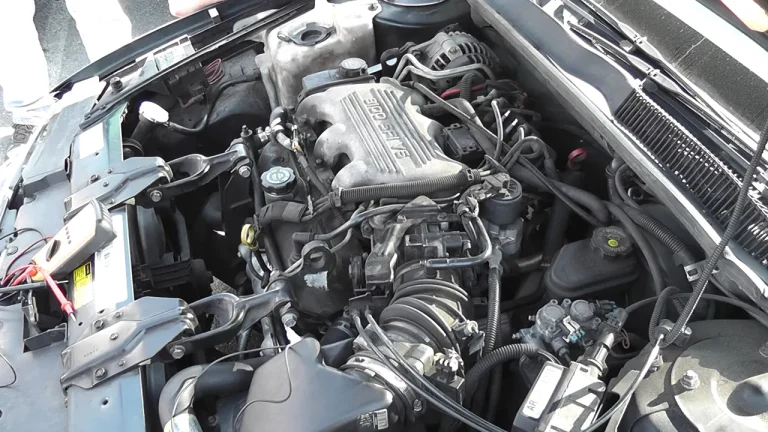How Long Can You Drive With an Oil Leak? Find Out the Limit!
You can drive with an oil leak until the leak gets worse or causes engine damage. However, it is not recommended to drive with an oil leak for an extended period of time as it can lead to major engine problems and potential breakdowns.
Neglecting an oil leak can result in low oil levels, loss of lubrication, and engine overheating, which can cause irreversible damage to the engine components. It is essential to address an oil leak promptly and have it repaired by a professional mechanic to avoid costly repairs and ensure the longevity of your vehicle.
Understanding The Severity Of An Oil Leak
An oil leak may seem like a small issue, but it can have serious consequences for your vehicle’s engine if left unchecked. It is important to understand the severity of an oil leak and take immediate action to prevent further damage.
In this section, we will discuss the importance of regular oil changes, signs and symptoms of an oil leak, and how oil leaks can lead to engine damage.
Importance Of Regular Oil Changes:
Regular oil changes are crucial for the overall health and performance of your vehicle. Here’s why:
- Lubrication: Oil lubricates the moving parts of the engine, reducing friction and preventing wear and tear. It ensures that all the components work together smoothly.
- Cooling: Oil also helps in dissipating heat generated by the engine. It keeps the temperature under control and avoids overheating.
- Cleansing: Over time, oil breaks down and accumulates dirt and particles. Regular oil changes help remove these impurities and keep the engine clean.
- Seal protection: Oil forms a protective layer on the engine seals, preventing leaks. Fresh oil ensures that the seals remain in good condition, reducing the risk of leaks.
Signs And Symptoms Of An Oil Leak:
Detecting an oil leak early can save you from costly repairs down the line. Look out for these signs and symptoms:
- Oil spots or puddles under the vehicle: One of the most obvious signs of an oil leak is finding oil spots or puddles underneath your car after it has been parked.
- Burning smell: If you notice a persistent burning smell while driving, it could be due to oil leaking onto hot engine parts.
- Engine overheating: Insufficient oil can cause the engine to overheat. Keep an eye on the temperature gauge and be wary of any sudden increases.
- Smoke from the engine: Oil dripping onto exhaust components can lead to smoke or steam coming from the engine area.
- Low oil levels: Regularly check your oil levels using the dipstick. If you notice a significant decrease in oil levels between changes, it could indicate a leak.
How Oil Leaks Can Cause Engine Damage:
Ignoring an oil leak can result in severe engine damage. Here’s how oil leaks can harm your engine:
- Lack of lubrication: Reduced oil levels due to a leak can lead to inadequate lubrication, causing excessive friction between moving parts. This can result in engine components wearing out faster and potential engine failure.
- Overheating: If the leak is significant enough, the oil level may drop to a point where it can no longer cool the engine effectively. Overheating can warp internal parts, leading to expensive repairs.
- Contamination: Oil leaks can contaminate other engine fluids, such as coolant. This can impact their effectiveness and affect the overall performance of the engine.
- Expensive repairs: Ignoring an oil leak can ultimately lead to costly engine repairs or even the need for a complete engine replacement.
Understanding the severity of an oil leak is vital for maintaining the longevity and performance of your vehicle. Regular oil changes, early detection of leaks, and prompt repairs are essential to prevent engine damage. If you suspect an oil leak, it is wise to consult a professional mechanic to assess and address the issue promptly.
Remember, a small oil leak today can turn into a more significant problem tomorrow, so don’t delay in taking action.
Factors That Determine How Long You Can Drive With An Oil Leak
When it comes to an oil leak in your vehicle, it’s important to address the issue promptly to avoid potential damage to your engine. The longevity of your ability to drive with an oil leak depends on several factors. Let’s delve into these factors and understand how they can determine how long you can drive with an oil leak.
The Type And Size Of The Oil Leak:
\- small leaks: if you have a small oil leak, such as a minor gasket leak or a loose drain plug, you may be able to drive for a short period without immediate consequences. However, it’s crucial to get it fixed soon to prevent further damage.
\- large leaks: a significant oil leak, such as a cracked oil pan or a severed oil line, requires immediate attention. Continuing to drive with such a leak can rapidly deplete your oil supply and lead to catastrophic engine failure.
The Rate Of Oil Loss:
- Slow oil loss: In cases where the leak is minor or the oil loss is slow, you may have some time before needing immediate repairs. Regularly monitoring your oil level and topping it up can buy you some extra miles, but seek professional help as soon as possible.
- Rapid oil loss: If your vehicle experiences a rapid oil loss due to a major leak, driving becomes riskier. The engine may not receive enough lubrication, leading to excess friction and overheating. Without sufficient lubrication, engine components can wear out quickly, resulting in severe damage.
The Condition And Age Of The Engine:
- Newer engines: If you have a newer engine in good condition, it may be able to tolerate an oil leak for a shorter period. However, it’s still important to address the issue promptly to avoid any potential damage that could escalate over time.
- Older engines: Older engines are generally less forgiving when it comes to oil leaks. They may have accumulated more wear and tear, making them more susceptible to damage caused by insufficient lubrication. It’s crucial to address any oil leaks in older engines immediately.
Now that you know the key factors that determine how long you can drive with an oil leak, it’s essential to take action when faced with such a situation. Remember, even if you can drive for a short period, it’s best to get the leak fixed as soon as possible to keep your engine in good health.
Potential Consequences Of Driving With An Oil Leak
Driving with an oil leak can have far-reaching consequences for both your vehicle and your wallet. Ignoring this issue can lead to increased risk of engine failure, reduced fuel efficiency, and expensive repairs and maintenance costs. Let’s delve deeper into these potential outcomes:
Increased Risk Of Engine Failure
- Insufficient lubrication: An oil leak means that your engine is not receiving the necessary lubrication to function properly. Without proper lubrication, the engine components may experience excessive friction and wear, leading to serious damage.
- Overheating: Oil helps to cool down the engine by dissipating the heat generated during operation. When there is a leak, the oil level drops, reducing the cooling effect. This can cause the engine to overheat, potentially resulting in catastrophic engine failure.
Reduced Fuel Efficiency
- Increased friction: With an oil leak, the engine’s moving parts grind against each other, producing additional friction. This friction requires more power from the engine, causing it to work harder and burn more fuel than necessary.
- Incomplete combustion: When oil leaks into the combustion chamber, it may interfere with the optimal fuel-air mixture, leading to inefficient combustion. The engine ends up burning excess fuel, further reducing fuel efficiency.
Expensive Repairs And Maintenance Costs
- Engine damage: The longer you drive with an oil leak, the more damage your engine may incur. Repairing or replacing damaged engine components can be extremely costly, potentially reaching thousands of dollars.
- Other systems affected: An oil leak can impact other systems in your vehicle, such as the catalytic converter, oxygen sensors, or even the electrical system. Fixing these issues can add to the overall repair costs.
Addressing an oil leak promptly is crucial to avoid these consequences. Regularly checking your oil levels and looking out for any signs of leakage can help you catch the problem early. Remember, attending to oil leaks promptly not only protects your vehicle’s engine but also saves you from costly repairs and the hassle of unexpected breakdowns.
How To Identify And Locate An Oil Leak
Oil leaks can be a common issue for car owners, and if left unattended, they can cause serious damage to your vehicle’s engine. To prevent this from happening, it’s crucial to identify and locate oil leaks as soon as possible.
Here are some effective methods to help you with this task:
Visual Inspection Of The Engine And Surrounding Components
Performing a visual inspection is the first step in detecting an oil leak. By examining the engine and its surrounding components, you can quickly identify any visible signs of leaking oil. Here’s what you should look for:
- Check underneath the car for any oil puddles or drips on the ground.
- Inspect the engine’s valve cover and oil pan for signs of oil accumulation or wetness.
- Examine the gaskets and seals for any signs of wear or damage.
- Look for oil stains or residue on the engine block, hoses, and fittings.
- Inspect the oil filter and the area around it for any indications of leaks.
- Pay attention to any unusual smells, such as a burning oil odor.
Use Of Uv Dye To Detect Leaks
In some cases, visual inspection may not be enough to pinpoint the exact location of an oil leak. This is where uv dye can come in handy. Uv dye is a fluorescent liquid that can be added to your engine’s oil.
Here’s how it works:
- Add the uv dye to your engine’s oil following the manufacturer’s instructions.
- Run the engine for a short period of time to allow the dye to circulate throughout the system.
- Use a uv light or lamp to inspect the engine and its components.
- The uv dye will illuminate under the uv light, making it easier to identify the source of the leak.
Seeking Professional Assistance If Needed
If you’re unable to locate the oil leak or if you’re unsure about identifying it yourself, it’s always best to seek professional assistance. A qualified mechanic can use specialized tools and diagnostic equipment to accurately diagnose and fix the issue.
They have the experience and knowledge to handle oil leaks efficiently and effectively.
Remember, promptly addressing an oil leak can save you from larger problems down the road. Whether you detect the leak through visual inspection, utilize uv dye, or seek professional help, taking immediate action can prolong the life of your vehicle’s engine and help you avoid costly repairs.
Steps To Take When You Discover An Oil Leak
Check The Oil Level And Condition
When you discover an oil leak in your vehicle, it’s important to assess the situation and take appropriate action. The first step is to check the oil level and condition to get a better understanding of the severity of the leak.
Here are some key points to consider:
- Check the dipstick: Start by locating the dipstick, which is usually labeled and located near the engine. Pull it out and wipe off any oil before reinserting it fully. Then pull it out again to check the oil level.
- Assess the oil level: The dipstick will have markers indicating the minimum and maximum oil levels. Make sure the oil level falls within this range. If it’s below the minimum mark, you may need to add more oil.
- Examine the oil condition: Take note of the oil’s color and consistency. Healthy oil should have a clear, amber color. If the oil appears dirty, gritty, or has a burnt smell, it could be an indication of a more serious problem.
Assess The Severity Of The Leak
Once you’ve checked the oil level and condition, it’s time to assess the severity of the oil leak. Here are some steps to follow:
- Identify the source: Carefully inspect the engine and surrounding components to locate the source of the leak. Common areas where leaks occur include the oil pan, valve cover, oil filter, or oil cooler.
- Determine the leak rate: Assess how quickly the oil is leaking. If it’s a slow leak and you only notice a few drops on the ground after parking for a while, it may be less urgent. However, if the leak is substantial and you’re losing a significant amount of oil, immediate attention is needed.
- Consider the consequences: Evaluate the potential consequences of driving with an oil leak. Oil plays a crucial role in lubricating the engine and preventing friction. Continued driving with a severe leak can lead to engine damage and increased repair costs.
Decide Whether To Continue Driving Or Seek Immediate Repairs
The final step is to decide whether it is safe to continue driving with the oil leak or if immediate repairs are necessary. Here are some factors to consider:
- Severity of the leak: Based on your assessment, determine the severity of the oil leak. If it’s a minor leak with minimal impact on oil levels and engine performance, you may be able to drive short distances to a repair shop. However, if the leak is severe or you’re losing oil rapidly, it’s best to avoid driving until the issue is resolved.
- Distance to repair shop: Consider the proximity of a reliable repair shop. If you’re in a remote area or far from assistance, it may be safer to tow the vehicle to prevent further damage.
- Personal safety: Always prioritize your safety and the safety of others on the road. If the oil leak is accompanied by smoking, burning smells, or warning lights on the dashboard, it’s crucial to stop driving immediately and seek professional assistance.
Remember, addressing an oil leak promptly can prevent potential engine damage and ensure your vehicle operates at its best. When in doubt, consult with a certified mechanic to get expert advice on the best course of action.
Tips To Minimize Damage While Driving With An Oil Leak
Driving with an oil leak can pose serious risks to your vehicle’s engine and overall performance. However, there are some steps you can take to minimize any potential damage. Here are some helpful tips to keep in mind:
Top Up The Engine Oil Regularly
- Regularly check and top up the engine oil to ensure that the oil levels are at an optimal range.
- By maintaining the proper oil level, you can ensure that all components of the engine are effectively lubricated, reducing the risk of damage.
- Keep a close eye on any oil consumption patterns. If you notice a significant decrease in oil level within a short period, it may indicate a more severe leak issue that should be addressed promptly.
Monitor The Oil Level And Watch For Any Sudden Changes
- Keep a regular check on the oil level and monitor any sudden changes. A sudden drop in oil level can indicate a more significant oil leak problem.
- If you notice a significant decrease in oil level or any sudden changes, it is essential to address the issue immediately to prevent further damage to your engine.
- Monitor the color and consistency of the oil as well. Any sudden changes in color or texture can be a warning sign of potential issues and should be investigated.
Avoid Driving In Extreme Conditions Or For Long Distances
- Driving in extreme conditions such as high temperatures or extreme cold can intensify the impact of an oil leak. It is best to avoid exposing your vehicle to such conditions.
- Similarly, avoid driving for long distances with an oil leak as it can lead to a more significant loss of oil and potentially cause severe damage to the engine.
- If you need to drive, keep an eye on the oil levels and be prepared to stop and address any issues that arise.
Remember, while these tips can help minimize damage while driving with an oil leak, it is crucial to address the leak itself as soon as possible. Consult with a professional mechanic to diagnose and fix the leak to ensure the long-term health and performance of your vehicle.
By following these tips, you can take proactive steps to protect your engine and minimize any potential damage caused by an oil leak. Safe driving!
When To Seek Professional Help For An Oil Leak
If you notice an oil leak in your car, it is crucial to take immediate action to avoid potential damage and expensive repairs. While some minor leaks can be fixed with diy methods, certain signs indicate that it’s time to seek professional help.
Here are three indicators that should prompt you to consult a mechanic:
Persistent Or Worsening Oil Leak
- A consistent drip of oil under your vehicle.
- Oil stains on your driveway or parking spot.
- A burning smell coming from the engine.
- Oil levels decreasing quickly, requiring frequent top-ups.
If you experience any of these symptoms, it’s best to entrust the repair work to a professional mechanic. They have the expertise to diagnose the issue accurately, repair the leak, and prevent further damage to your engine.
Unusual Engine Noises Or Vibrations
- Abnormal knocking or clicking sounds while the engine is running.
- Rumbling or vibrating sensations.
- Loss of power or acceleration.
When you hear unusual noises or feel strange vibrations coming from your engine, it could indicate a significant problem related to the oil leak. These symptoms suggest that the leak has resulted in insufficient lubrication, causing friction and improper functioning of engine components.
In such cases, it is advisable to consult a professional to avoid further damage and potential breakdowns.
Engine Warning Lights Or Reduced Performance
- Illumination of the oil pressure warning light on your dashboard.
- Reduced engine performance, such as sluggish acceleration.
- Overheating of the engine.
These signs indicate that the oil leak has reached a critical level, affecting the overall performance and safety of your vehicle. Engine warning lights serve as an important indicator that professional attention is required, as they can identify specific issues through diagnostic codes.
Additionally, reduced performance and overheating are clear indicators of severe oil leak consequences.
While minor oil leaks can be addressed through diy methods, persisting leaks, unusual engine noises or vibrations, and warning lights or reduced performance all suggest that it’s time to seek professional help. Remember, early detection and prompt action can save you from costly repairs and ensure the longevity of your vehicle.
Don’t hesitate to consult a professional mechanic when faced with these signs of an oil leak.
Frequently Asked Questions About Driving With An Oil Leak
**frequently asked questions about driving with an oil leak**
Can i use a stop leak additive to temporarily fix the issue?
- Yes, you can use a stop leak additive as a temporary solution for an oil leak. Here are some key points about using stop leak additives:
- Stop leak additives work by swelling the seals and gaskets in the engine, helping to prevent or reduce oil leaks.
- They are easy to use and can be poured directly into the engine oil.
- Stop leak additives are designed to provide a temporary fix, and it is recommended to have the leak repaired by a professional as soon as possible.
- Keep in mind that stop leak additives may not work for all types of oil leaks and their effectiveness can vary depending on the severity of the leak.
How Much Does It Cost To Repair An Oil Leak?
- The cost of repairing an oil leak can vary depending on several factors. Here are some key points to consider:
- The extent and location of the oil leak: The cost will vary depending on the severity of the leak and the parts that need to be replaced.
- The type of vehicle: Repair costs can vary depending on the make and model of the vehicle.
- Labor and parts: The cost will include both the labor charges for the repair work and the cost of any parts that need to be replaced.
- It is recommended to get a professional inspection and estimate to determine the exact cost of repairing an oil leak in your specific case.
Will Insurance Cover The Costs Of Repairs?
- Whether insurance will cover the costs of repairing an oil leak depends on your insurance policy and the circumstances surrounding the leak. Here are some key points to keep in mind:
- Comprehensive coverage: If you have comprehensive coverage, it may cover the costs of repairing an oil leak caused by factors such as vandalism or theft.
- Routine wear and tear: Most insurance policies do not cover repairs for oil leaks that result from routine wear and tear or lack of proper maintenance.
- Deductible: If the repair costs are less than your deductible, it may not be worth filing an insurance claim.
- Contact your insurance provider: It is recommended to contact your insurance provider and review your policy to understand what is covered in case of an oil leak.
Remember, while temporary solutions like stop leak additives can provide a temporary fix, it is important to have the oil leak repaired by a professional as soon as possible to avoid further damage to your engine. Understanding the potential costs involved and checking your insurance coverage can help you make informed decisions when dealing with an oil leak.
Conclusion
Driving with an oil leak can have serious consequences for both your vehicle and your safety. Ignoring an oil leak can lead to engine damage, reduced fuel efficiency, and even complete engine failure. It’s crucial to address the issue as soon as possible to prevent further damage.
Regularly checking your oil levels and monitoring for any signs of leakage, such as oil spots under your vehicle or a burning smell, can help you detect a leak early on. Consulting a professional mechanic is the best course of action to identify the source of the leak and perform any necessary repairs.
Remember, neglecting an oil leak can result in costly repairs and possible breakdowns on the road, so it’s always better to be proactive and address the issue promptly.
- Why Are My Car Headlights Not Bright Enough? - May 9, 2024
- How Long Can You Drive With An EVAP Leak? - May 9, 2024
- What Does B Stand for in a Car? [Full Guide] - May 9, 2024


![Toyota Venza Years to Avoid [Guide for Car Buyers]](https://automhelp.com/wp-content/uploads/2023/07/This-is-BAD-BEWS-For-Toyota-Venza-Owners_000097353-768x432.webp)


![How Much Should It Cost to Replace a CV Axle? [2024]](https://automhelp.com/wp-content/uploads/2023/12/New-CV-Axle-Installation-And-Cost_000051733-2-768x432.webp)